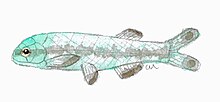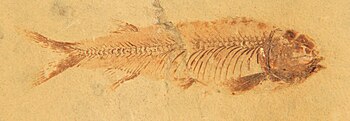Lycoptera
| Lycoptera Temporal range:
| |
|---|---|

| |
| L. davidi, from Yixian, Liaoning, China, Lower Cretaceous (Aptian) | |
| Scientific classification | |
| Domain: | Eukaryota |
| Kingdom: | Animalia |
| Phylum: | Chordata |
| Class: | Actinopterygii |
| Order: | †Lycopteriformes |
| Family: | †Lycopteridae |
| Genus: | †Lycoptera Müller, 1847 |
| Type species | |
| †Lycoptera middendorffi Müller, 1847
| |
| Species | |
| Synonyms | |
| |
Lycoptera is an extinct genus of fish that lived from Lower Cretaceous, Barremian to Aptian[1] in present-day China, North Korea,[2] Mongolia and Siberia. Although there is record from Jurassic Formation in Siberia, its age remains questionable.[3] It is known from abundant fossils representing sixteen species, which serve as important index fossil used to date geologic formations in China. Along with the genus Peipiaosteus, Lycoptera has been considered a defining member of the Jehol Biota, a prehistoric ecosystem famous for its feathered dinosaurs, which flourished for 20 million years during the Early Cretaceous, where it occurs abundantly in often monospecific beds, where they are thought to have died in seasonal mass death events.[4][5] Lycoptera is a crown group teleost belonging to an early diverging lineage of the Osteoglossomorpha, which contains living mooneyes, arapaima, arowana, elephantfish and knifefish/featherbacks.[6]
Description[edit]

Lycoptera species were small freshwater fish. Most species fed on plankton, and had numerous tiny teeth. A few species like L. gansuensis, L. muroii, and L. sinensis had larger teeth and probably fed on small insects and their larvae.[7]
Many specimens preserve minute details and impressions of soft tissues. Lycoptera was covered in tiny oval scales about 1.2 millimeters across, and, in life, would have had a superficial resemblance to the common minnow.[8]
Lycoptera fossils are commonly found in large groups, buried together quickly in fine lake sediments likely due to mass death events from seasonal upwelling of anoxic waters during late autumn and winter.[5] This had led to suggestions that they were gregarious in life, congregating in shoals.[7]
Classification and species[edit]


Sixteen species of Lycoptera have been described, nine from the Jehol Group. The table below is based primarily on the valid species listed by Zhang and Jin in the 2008 book The Jehol Fossils.[7]
| Name | Author | Year | Status | Notes |
|---|---|---|---|---|
| Lycoptera middendorffi | Müller | 1847 | Valid, type species | |
| Lycoptera macrorhyncha | (Eichwald) | (1868) | ||
| Lycoptera davidi | (Sauvage) | (1880) | Valid | |
| Lycoptera sinensis | Woodward | 1901 | Valid | |
| Lycoptera ferox | Grabau | 1923 | ||
| Lycoptera chosenensis | Makiyama | 1927 | ||
| Lycoptera kansuensis | Grabau | 1928 | ||
| Lycoptera woodwardi | Grabau | 1928 | ||
| Lycoptera jaholensis | Grabau | 1928 | ||
| Lycoptera fragilis | Hussakof | 1932 | Valid | |
| Lycoptera takunagai | Seito | 1936 | Valid | |
| Lycoptera muroii | (Takai) | (1943) | Valid | |
| Lycoptera longicephalus | Liu et al. | 1962 | Valid | |
| Lycoptera lunteensis | Liu et al. | 1962 | ||
| Lycoptera polyspondylus | Liu et al. | 1962 | ||
| Lycoptera tungi | Liu et al. | 1962 | ||
| Lycoptera wangi | ||||
| Lycoptera sankeyushuensis | (Ma & Sun) | (1988) | Valid | |
| Lycoptera fuxinensis | Zhang | 2002 | Valid |
References[edit]
- ^ Cavin, Lionel; Piuz, André; Ferrante, Christophe; Guinot, Guillaume (2021-06-03). "Giant Mesozoic coelacanths (Osteichthyes, Actinistia) reveal high body size disparity decoupled from taxic diversity". Scientific Reports. 11 (1): 11812. Bibcode:2021NatSR..1111812C. doi:10.1038/s41598-021-90962-5. ISSN 2045-2322. PMC 8175595. PMID 34083600.
- ^ Gao, K.; Li, Q.; Wei, M.; Pak, H.; Pak, I. (2009). "Early Cretaceous birds and pterosaurs from the Sinuiju Series, and geographic extension of the Jehol Biota into the Korean Peninsula" (PDF). Journal of the Paleontological Society of Korea. 25 (1): 57–61.
- ^ Jolivet, Marc; Arzhannikova, Anastasia; Frolov, Andrei; Arzhannikov, Sergei; Kulagina, Natalia; Akulova, Varvara; Vassallo, Riccardo (2017). "Late Jurassic - Early Cretaceous paleoenvironmental evolution of the Transbaikal basins (SE Siberia): implications for the Mongol-Okhotsk orogeny". Bulletin de la Société géologique de France. 188 (1–2): 9. doi:10.1051/bsgf/2017010. ISSN 0037-9409.
- ^ Jin, F., Zhang, F.C., Li, Z.H., Zhang, J.Y., Li, C. and Zhou, Z.H. (2008). "On the horizon of Protopteryx and the early vertebrate fossil assemblages of the Jehol Biota." Chinese Science Bulletin, 53(18): 2820-2827.
- ^ a b Pan, Yanhong; Fürsich, Franz T.; Zhang, Jiangyong; Wang, Yaqiong; Zheng, Xiaoting (May 2015). Jagt, John (ed.). "Biostratinomic analysis of Lycoptera beds from the Early Cretaceous Yixian Formation, western Liaoning, China". Palaeontology. 58 (3): 537–561. doi:10.1111/pala.12160. ISSN 0031-0239. S2CID 129362287.
- ^ Hilton, Eric J.; Lavoué, Sébastien (2018-10-11). "A review of the systematic biology of fossil and living bony-tongue fishes, Osteoglossomorpha (Actinopterygii: Teleostei)". Neotropical Ichthyology. 16 (3). doi:10.1590/1982-0224-20180031. ISSN 1982-0224.
- ^ a b c Zhang, J.Y.; Jin, F. (2008). "Fishes". In Chen, P.; Zhang, M.; Wang, Y. (eds.). The Jehol fossils: the emergence of feathered dinosaurs, beaked birds and flowering plants. Academic Press. pp. 69–76. ISBN 9780123741738.
- ^ Cockerell, Theodore D.A. (1922). "The affinities of the fish Lycoptera middendorffi". Bulletin of the American Museum of Natural History. 51 (8). hdl:2246/1319.



